Starter fertilizer will often result in increased early- season growth. Although it is difficult to predict exactly where and when yield responses occur, it is easy to provide conditions that improve the potential for response. These include the following:
Low Phosphorous Availability:
Corn plants need a readily available supply of phosphorous early in the growing season. It is especially important that the plants have phosphorous near the row on low testing soils. Soil tests below 20 ppm are considered low. However, even on medium to higher testing soils there is data that shows starter will increase yields in cool damp soil conditions.
Cool Soil Temperature:
Reduced tillage systems increase residue left on soil surface, as a result reduce soil temperature early in the growing season. This reduced soil temperatures slows root growth, and reduces nutrient uptake unless the nutrients are near the seed. Low temperatures also reduce the rate of microbial release of nitrogen from soil organic matter. Therefore some nitrogen near the seed can be an important thing.
Where Should I Place Starter Fertilizer:
Most common two practices for starter placement is 2 inches below and 2 inches to the side of the seed. Or in furrow placement, which is very near seed placed in seed trench. There are only certain starters that can be placed with the seed that are seed safe.
There are other reasons that in furrow starter placement can have advantages for farmers:
Carrier for micro nutrient packages, carrier for insecticides, cheaper equipment costs on corn planter.
In conclusion there are many options and “what ifs” when it comes to starters. In my past experiences I feel starter can definitely pay for itself more years than not.
Tom Arndt




